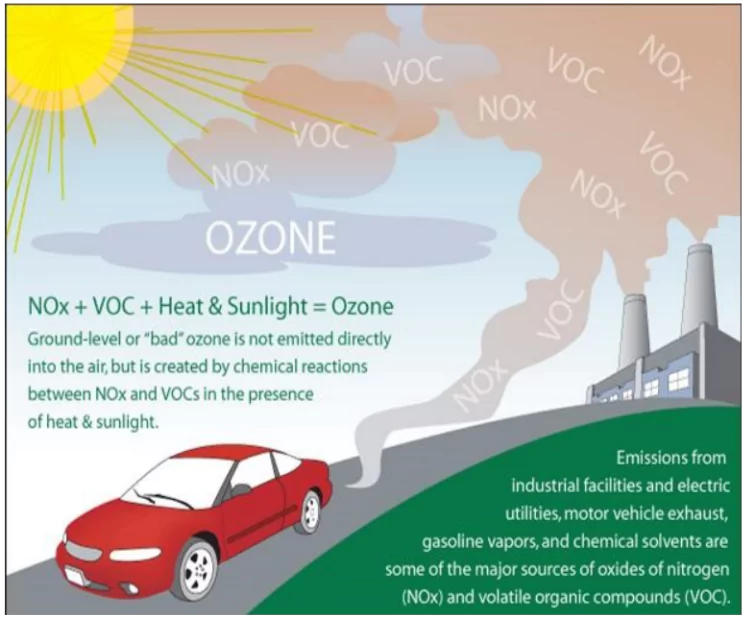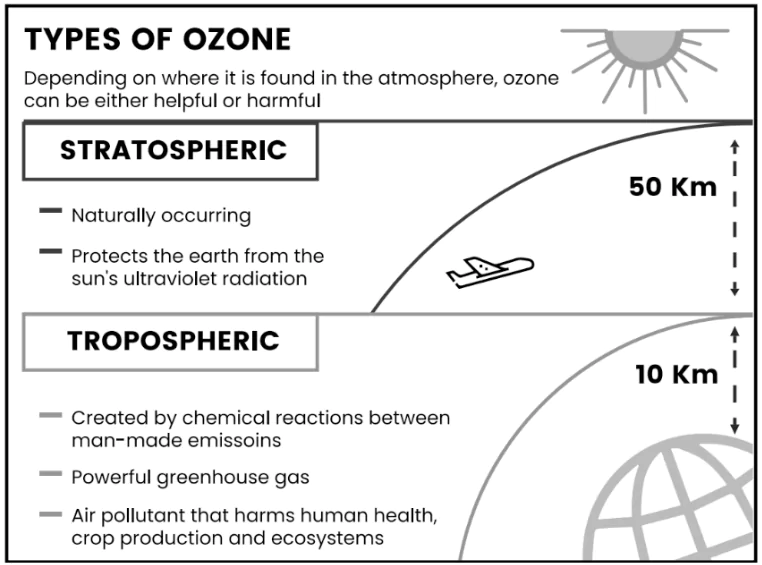The National Green Tribunal (NGT) has sought a response from the Centre regarding the implementation of the Central Pollution Control Board (CPCB) recommendations for controlling ozone levels in Delhi.
Key Findings of CPCB Report
- Exceeding Standards: Ozone concentrations surpassed the national standard (100 µg/m³ for 8 hours) at several monitoring stations.
- Peak Concentrations: Nehru Nagar recorded 224.9 µg/m³, Patparganj 188.3 µg/m³, and RK Puram 175.4 µg/m³. Nehru Nagar had 56 days, Patparganj 45 days, and Aurobindo Marg 38 days of elevated ozone levels in 2023.
- Traffic-Heavy Areas: Dangerous levels were observed in several high-traffic locations during April-May 2023.
- Precursors and Causes: Major contributors include vehicular emissions, biomass burning, and industrial activities, with influence from transboundary movement and biogenic emissions.
Enroll now for UPSC Online Classes
About Ground-Level Ozone (GLO)/ Tropospheric Ozone

- Formation: Ground-level ozone is a colorless photochemical pollutant formed just above the Earth’s surface.
- It is a secondary pollutant created when precursor pollutants (NOx and VOCs) react in the presence of sunlight.
- Photochemical pollutants are formed when sunlight reacts with primary pollutants like nitrogen oxides and volatile organic compounds (VOCs) in the atmosphere.
- Peak Levels: Ozone levels peak during summers as rising temperatures, particularly during heatwaves, exacerbate ground-level ozone formation, leading to dangerous air quality.
- Sources of Precursor Pollutants: Major sources of include vehicular emissions, fossil fuel power plants, oil refineries, and the agriculture sector.
- NOx: Nitrogen oxides (NO, NO₂) emitted from combustion.
- VOCs: Volatile organic compounds (e.g., benzene, toluene) that evaporate readily from the volatile fuels.
 Types of Ozone
Types of Ozone-
- Tropospheric Ozone (Ground-Level Ozone): Harmful air pollutants are referred to as “bad ozone.”
- Stratospheric Ozone: Protective ozone layer in the upper atmosphere that shields the Earth from harmful ultraviolet (UV) radiation, it is also known as good Ozone.
- Standards of GLO: National Ambient Air Quality Standards (NAAQS) has set the safe limit of ambient ozone levels.
- 8-hour average: 100 µg/m³.
- 1-hour limit: 180 µg/m³.
National Ambient Air Quality Standards (NAAQS)
- NAAQS are standards set by the Central Pollution Control Board (CPCB) in India to define the permissible limits of various pollutants in the ambient air.
- Objective:To protect human health and the environment from the harmful effects of air pollution.
- Pollutants Covered: NAAQS cover major air pollutants like particulate matter (PM2.5, PM10),sulphur dioxide (SO2), nitrogen dioxide (NO2), ozone (O3), carbon monoxide (CO), and lead.
- Classification: NAAQS are classified into different categories based on sensitive areas (residential, industrial, and rural areas).
- Implementation: State Pollution Control Boards (SPCBs) are responsible for monitoring air quality and enforcing NAAQS within their respective jurisdictions.
- Significance: NAAQS play a crucial role in controlling air pollution by setting clear targets for air quality improvement and guiding pollution control strategies.
|
Impacts of Ground-Level Ozone
- Health Impacts:
- Increased risk of heart attacks and strokes: Ozone can inflame the lining of the lungs, which can lead to increased blood pressure and heart rate, making people more susceptible to cardiovascular events.
- It causes 1 million premature deaths annually worldwide.
- Reduced lung function: Long-term exposure to ozone can permanently damage lung tissue, reducing lung function and making it more difficult to breathe. It aggravates asthma, bronchitis, and other respiratory conditions.
- Weakened immune system: Ozone exposure can suppress the immune system, making individuals more vulnerable to infections.
- Eye irritation: Ozone can irritate the eyes, causing redness, watering, and even temporary vision problems.
- Climate Impacts:
- Acts as a strong greenhouse gas: Tropospheric ozone (O3) is the third most important anthropogenic greenhouse gas after carbon dioxide (CO2) and methane (CH4).
- Indirectly affects climate change: Ozone can react with other pollutants to form secondary pollutants, such as particulate matter, which can further contribute to climate change.
- Affects weather patterns: Ozone can alter weather patterns by changing atmospheric circulation and temperature.
- Agriculture and Ecosystem Impacts:
- Reduced forest growth and productivity: Ozone can damage trees and other vegetation, reducing their growth and productivity.
- Increased susceptibility to pests and diseases: Ozone stress can weaken plants, making them more susceptible to pests and diseases.
- Loss of biodiversity: Ozone pollution can harm sensitive ecosystems, leading to a loss of biodiversity.
Check Out UPSC NCERT Textbooks From PW Store
Recommendations for Ozone Control
- Ozone control is primarily achieved by reducing its precursors: Nitrous oxides (NOx), volatile organic compounds (VOCs), methane, and carbon monoxide (CO).
- Localized control of precursors may not significantly reduce ozone levels as both ozone and its precursors can travel over long distances.
- National-level initiatives are essential for addressing these precursors effectively.
Measures Taken to Control Precursors of Ozone (NOx and VOCs)
- National Clean Air Programme (NCAP) (2019)
- Aims to reduce air pollution across India.
- City-specific clean air action plans implemented in 130 non-attainment cities.
- BS VI Vehicles: Reduced NOx emissions by up to 87% for heavy vehicles and 70-85% for two-wheelers.
- Electric Mobility: Promoted under PM-E initiative to achieve zero vehicular emissions.
- Revised Industrial Emission Standards: Stricter NOx and VOC standards for industries such as fertilizers and thermal power plants.
- Vapor Recovery System (VRS): Installed at petrol pumps in Delhi-NCR to reduce VOC emissions during refueling.
Also Read: Rising Ozone Pollution In Urban India: CSE Report
![]() 31 Dec 2024
31 Dec 2024


 Types of Ozone
Types of Ozone